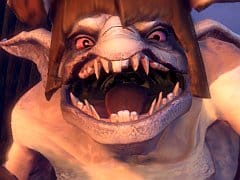Video Gamer is reader-supported. When you buy through links on our site, we may earn an affiliate commission. Prices subject to change. Learn more
Has Peter Molyneux finally taken things too far? That seems to be the view of some people out here in Los Angeles. Initial reactions to Fable: The Journey at Microsoft’s presser ranged from confusion to derision to something bordering on enmity. A horse-and-carriage Kinect game? An on-rails Fable? What the hell was he thinking?!
Despite being a big fan of the man – and, if I’m honest, something of a Molyneux apologist – I was prepared for the worst when I went along to check the game out. To my surprise, however, my feelings have now changed. I can’t say concerns have been entirely dispelled, but I’m certainly intrigued by the project, and rather eager to try it out for myself; unfortunately this first showing was a hands-off demonstration.
Fable: The Journey essentially dumps you in the driver’s seat of a horse-drawn wagon and then tasks you with travelling 300 miles to The Spire – that big pointy building of Fable II notoriety. In the back of your virtual carriage is Theresa, the blind seer and series narrator, voiced by Zoe Wanamaker. Lady T is in a bad way, and she needs to get to the tower ASAP – but if that’s not enough of a motive for haste, you’re also being chased by The Corruption, the evil Marmite-type stuff from Fable III.
Enough plot gubbins, already. In practical terms there are two styles of gameplay here: riding sequences, in which you drive your nag across Albion, and combat bits, in which you blast people with magical attacks.
In the former, you guide your vehicle with simple, steady stretching gestures, in a simplified approximation of what you’d be doing with actual reins. There doesn’t seem to be anything particularly taxing here, movement wise – just steering, and a ‘giddyup’ motion to go faster. The meat of the gameplay seems to stem from the tension between the desire to stop and pick up important items or explore diversions, and the ongoing need to press on.
Dawdling too much will allow The Corruption to close in on you, demanding that you flee at speed over what might be rather hazardous terrain; Molyneux wouldn’t explicitly state whether or not the player can die, but it’s certainly possible to plough over the edge of a cliff, from the sounds of things.
At the same time, it will be important to power yourself up by pausing to collect crystals and other items along the way, as these are essential for powering up your magic attacks. At one point in the demo the player passed the entrance to a mine, and apparently you’ll be able to stop and go in, with the inside unravelling as a self-contained dungeon or instance.
Pressing Molyneux to explain the overall structure of the game yielded typically mysterious (read: vague) results. In short he’s saying that everyone will pass through the same major events, but the nature of the journey will vary from player to player – and there will be branching points, possibly tied in to the actions you take at specific moments.
I’m taking all this to mean that it’ll be like Outrun. With a horse.
At least the combat side of the show seems a little more straightforward. Each of your hands controls a separate circular reticule, and can be independently used to lob balls of magic at your foes. Sweep the two magic blobs together, and you’ll blend them into a potent fireball. By making a cycling motion with both hands – like one of those crap 80’s dances – you’ll open a spellcrafting menu, which then allows you to build more complicated magical attacks. From the looks of things, these will include established Fable favourites, like enchanted blades and time manipulation.
But it doesn’t end there. If you come to a high cliff and fancy a look at the scenery ahead, you’ll also be able to make a telescope. You’ll also be able to make hammers and fishing rods, and God knows what else.
At one point we’re told that the player will need to drain energy from wild animals in order to survive. Drain a bit and the creature will fall asleep; drain more, and you’ll kill them. It’s all slightly bewildering, but Molyneux’s own demo did a vastly better job of selling the experience than the brief showing at Microsoft’s conference.
Needless to say, there was a near constant stream of verbal dynamite from the man himself. “We’ve got great horse sweat technology!” he grins. “I’m all for horse bodily functions!” And then later, in reference to the animal-draining: “Fluffy squirrels need to die!”
We’ve all learned to take this showmanship with a bucketful of salt, but here in the presence of the man himself, it’s virtually impossible to resist Molyneux’s effortless charm. And to be honest, I find myself liking a lot of the design choices. Fable: The Journey has been built so that you can play it sitting down, are there’ll be none of the leaping about that seems so popular with Kinect devs. The magic combat looks very simple, but it also looks to have a tactile quality that’s immediately appealing.
Lord knows how it’ll all turn out. Fable’s history is as littered with as many things that didn’t work (or didn’t show up at all) as it is with things that were genuinely interesting. But despite everything that’s come before – or perhaps because of it – Fable: The Journey has totally snagged my curiosity.

/https://oimg.videogamer.com/images/b175/fable_the_journey_9.jpg)